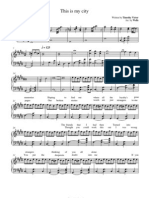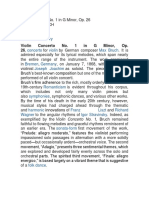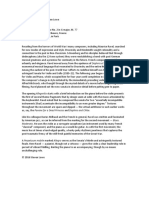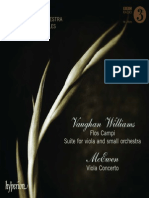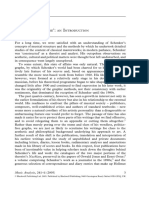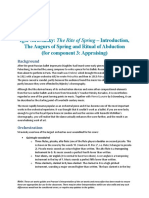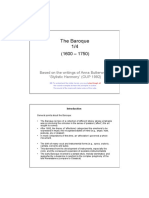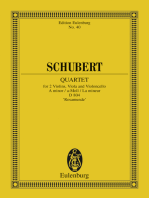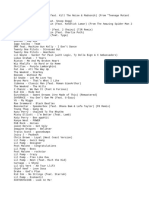Four Seasons Winter I - Vivaldi
Four Seasons Winter I - Vivaldi
Uploaded by
Dan GriffCopyright:
Available Formats
Four Seasons Winter I - Vivaldi
Four Seasons Winter I - Vivaldi
Uploaded by
Dan GriffOriginal Description:
Original Title
Copyright
Available Formats
Share this document
Did you find this document useful?
Is this content inappropriate?
Copyright:
Available Formats
Four Seasons Winter I - Vivaldi
Four Seasons Winter I - Vivaldi
Uploaded by
Dan GriffCopyright:
Available Formats
Daniel Griffin
HND 2 Classical
Laurie Crump
Critical Music Listening
Listening to different recordings of the same piece of music can really change the entire way you would view the piece. Throughout this paper I will discuss differences between the 2 recordings; Nigel Kennedy's Four Seasons with the English Chamber Orchestra and Fabio Biondi's same work with the Europa Galante. I will explore various aspects of the piece in order to show the main differences in each recording while explaining what effect this will have on the listener.
Section A bars 1-11 Section B bars 12-22
Aspects Arrangement Kennedy
Instead of the basso continuo line being played traditionally by a harpsichord Kennedy begins this eerie movement with only a lute strumming at only each chord change. The harpsichord finally enters half way through bar 40 when the pace of the music starts to move with the soloist and first violins dimish to semi quavers.
Biondi
Biondi's recording has the harpsichord playing from the very start. It is very heavy and present . At the start of each very first solo line the harpsichord still wanders around on notes even when the soloist has started playing.
Effect the differences make
Immediately the listener can identify the obvious differences between each recording. The Kennedy is a very subtle opening with not much happening at all which creates tremendous atmosphere. The Biondi one takes too big an approach at the start compared to the Kennedy. The notes are places much more delicately in Kennedy's version. The Kennedy recording is very interesting and unique at this point, particularly how he changes and bow position very radically for each phrase of the solo. It is a very contemporary thing where as in the Biondi I feel he stuck more to the traditional sound that Vivaldi might have been familiar with, especially the effect of trudging and shivering through snow relating to the poem the music is based on.
Dynamics
Kennedy's begins very quietly and the way each instrument enters with its line it makes the whole opening sound like an organ with different stops set to each voice. There is not much of a crescendo in the whole ensemble as a whole. The strings only become a little louder but the lute stays the same the whole way through basically. There is a surprising dynamic from the entry of the solo. The sound
In Biondi's recording the instruments start very obvious and the harpsichord very heavy and crispy. The whole A section trudges along as if trying to walk through a violent snow storm. There is a molto crescendo into the first entry of the solo at section B. During each solo section the violin does a little crescendo at the end of each phrase leading to a sforzando back to the accompanyment line.
Daniel Griffin
HND 2 Classical
Kennedy creates is a haunting screeching line most likely from playing sul ponticello letting all the harmonics ring through the notes he plays, but then the second entry he appears to come in late and attacks the string violently between the bridge and finger board, then finally the third solo phrase is played mostly likely sul tasto. From bar 20 onwards there is a great crescendo to an explosion into section C in bar 22.
Laurie Crump
Ornamentation
Unlike the written score, in the first orchestral tutti Kennedy puts trills in all parts of the orchestra rather than the solo only. The trills at the end of each entry of the solo at the beginning are drawn out and all very elegently decrescendo quickly at the endespecially the the end of the 3rd entry when there is even a piercing harmonic that is sounded.
The trills are only played in the soloists line from bars 1-11. The trill in bar 18 is really lingered on and delayed while the other 2 before are not subtlely placed in the music.
The effect Kennedy creates with trills in every part is terrific. It conjures up an image of someone shaking and shivering in the snow. At the end of the violent winter wind entries of the violin the indulgent trills signify the calm after each eruption, most notably the trill in bar 18 with the harmonic which marks the start of the crescendo to section C. They give a more harsh sound to the ear. This would make the listener notice them more although the harshness is not very fitting for the style of a baroque piece of music. Kennedy's recording has momentum to it and keeps the listener interested. I personally feel Biondi's phrasing very interupting to the flow of the piece.
Phrasing and Rubato There is a strong
During each solo metric rhythm section the violin does throughout all the a little crescendo at the sections. There are end of each phrase slight stressed notes at leading to a sforzando the start each time he back to the chord changes and its accompanyment line
Daniel Griffin
HND 2 Classical
mainly on first violins and solo. The flow of semi-quavers allows the music to 'jog' along and with the strict tempo this is very effective. The actual phasing is subtle but still present for the listener to identify. then. Biondi uses a great amount of rubato on every entry of the solo which interupts the flow of the music too much.
Laurie Crump
Section C bars 22-47
Aspects Rhythm, flow and ornamentation Kennedy
Kennedy keeps a strict tempo in the ensemble in the start of bars 2326. He continues to do so in the leading solo entry from 26-38 aswell. Every note is heard and played and the phrases in the passage feel natural and fluent. He also refers to the start of the movement in the quavers starting bar 40 by adding his own trills.
Biondi
Biondi keeps strict time at bars 23-26 but when he enters with the solo at 26 it disrupts the flow by his extensive use of rubato and overindulgent stressed notes at the beginning of a beat leading to a scale (third and fourth beats of bar 28). The flow feels broken slightly by what sounds like a missing note, in bar 31 going into the chromatic passage. Biondi takes an interesting approach to this section. To begin there is an outburst of power at the beginning of the C section but then a sudden diminuendo into bar 23 . He tries to create the actual effect of the weather being unpredictable so he varies the tempo and dynamic alot. The chromatic passage in bar 31 is much more prominent as the phrasing is a lot less subtle.
Effect the differences make
Keeping the momentum of the piece is a very important aspect of the piece at this point. Kennedy's recording achieves this, however Biondi's does not. Instead he decides to musically depict the winter storm with the stop and start scales. An actual storm would not flow so easily as Kennedy's would; the weather is unpredictable. The Kennedy recording surprises you with this dramatic start to the section. The hint in bar 14 and 15 of a frantic storm prepares you in a way but you really feel how consumed in the music Kennedy is. Biondi's recording I feel would come down to opinion of if you would want to hear the piece how it would normally be played with a strict metre. I do find it interesting how he creates the storm effect not only with the amount of notes vivaldi
Atmosphere
There is a dramatic change in the atmosphere at this point in the piece. Before, there was only one instance when the violin had a very fast and exciting line hinting on bars 14 and 15. The crescendo half way the phrase like in half way through bar 33 in the strings, gives sudden tremor to the next solo entry at the beginning of each bar.
Daniel Griffin
HND 2 Classical
Laurie Crump
wrote but focuses on how the notes are played more.
Articulation
In the start of bars 2326 the higher note in each part is very clearly stressed. This is commonly how these passages should be played to make them sound musical. The bars that follow with the solo continue this common method by highlighting the harmonic notes in the chord. For example in bar 32 the notes that are the clearest heard are at the beginning of each demi-semiquaver group which infact makes up the chord of C7.
Biondi does not make it clear where he is going with the phrasing with the way he articulates. Certain notes are stressed but they appear to be randomly placed at some points like the first note of the second beat of bar 27. The Bflat stands out from the other notes.
It is not as harsh in Kennedy's, especially the way he brings out the harmony notes in bar 32.
Section D bars 48-63
Aspects Timbre Kennedy Biondi Effect the differences make
With the bow being ricocheted by Biondi it creates a very distinctive sound quality which will definitely interest the listener or anyone who is not a string player theirself. It makes the piece sound a lot more modern than Kennedy's recording. Kennedy's notes are easier to identify while Biondi's are too quiet to hear clearly.
Every chord change on Biondi takes advantage the double stops is of a technique called fluent and clear. 'ricochet' for the double stops which involves bouncing the bow off the string and quickly tightening your grip to allow it to bounce rapidly .
Dynamics
Kennedy starts quiet in this section with subtle crescendos and diminuendos throughout until bar 54 and 55 as there is a great hairpin which bellows to piano at the end of the 2 bars.
The listener will struggle to hear what notes the soloist actaully plays in this from 47-55 as it is so quiet and delicate.
Daniel Griffin
HND 2 Classical
Laurie Crump
By comparing these pieces side by side we can understand clearly that a person can have a completely different interpretation of a piece depending on what recording they listen to. Personally I prefer the Kennedy as the Biondi tries to much to convince the listener what he is trying to express in his playing. Kennedy's is a lot more easy listening as his playing sounds a lot more natural to Biondi.
You might also like
- Words Don't Come Easy - F.R. DavidDocument1 pageWords Don't Come Easy - F.R. DavidRafael Santiago Adames MendozaNo ratings yet
- Haydn Op. 1 AnalysisDocument1 pageHaydn Op. 1 AnalysisMarco A. Gutiérrez CorderoNo ratings yet
- Benjamin Britten Sinfonietta 1932Document1 pageBenjamin Britten Sinfonietta 1932locrian54No ratings yet
- Suzuki Violin Method - Vol 01-02-03Document66 pagesSuzuki Violin Method - Vol 01-02-03feolivosNo ratings yet
- 7 N 13Document2 pages7 N 13BelitskayaViktoriaNo ratings yet
- Debussy's Influence On Bartok's MusicDocument5 pagesDebussy's Influence On Bartok's MusicSaz4eva100% (1)
- Timothy Victor - This Is My CityDocument2 pagesTimothy Victor - This Is My Cityy_wells9557No ratings yet
- Analisi Suite ModaleDocument57 pagesAnalisi Suite ModaleAndrea AdamoNo ratings yet
- Bill Evans - Rare Transcriptions Vol.3Document61 pagesBill Evans - Rare Transcriptions Vol.3Juliana Silveira100% (10)
- Schumann Piano Quintet in E Flat MajorDocument2 pagesSchumann Piano Quintet in E Flat MajorAngus Meryon100% (1)
- Listening Report On Mozart Violin Concerto No.4Document1 pageListening Report On Mozart Violin Concerto No.4Joy Danielle LlandinoNo ratings yet
- Galbraith Guitarist ArticleDocument2 pagesGalbraith Guitarist ArticleascbrightonNo ratings yet
- Canon in C (Fingerstyle) PDFDocument3 pagesCanon in C (Fingerstyle) PDFCamilo Andres ReyesNo ratings yet
- Russian Concertos AGDocument81 pagesRussian Concertos AGThierry BouilletNo ratings yet
- Vivaldi Four SeasonsDocument11 pagesVivaldi Four SeasonsFrancois le RouxNo ratings yet
- Bachs Ciacco Na StrohDocument44 pagesBachs Ciacco Na StrohJCNo ratings yet
- MatteisDocument5 pagesMatteisstefanodemicheliNo ratings yet
- Igor Stravinsky Suite From PulcinellaDocument1 pageIgor Stravinsky Suite From PulcinellaCleoNo ratings yet
- TeorieDocument414 pagesTeoriedavidNo ratings yet
- Franz Schubert Chamber Music PresentationDocument3 pagesFranz Schubert Chamber Music PresentationLia CriscuoloNo ratings yet
- Mozart Violin Concerto No 3 in G MajorDocument2 pagesMozart Violin Concerto No 3 in G MajorCASSIO UFPINo ratings yet
- Couperin, Lalande - Lecons de Tenebres PDFDocument24 pagesCouperin, Lalande - Lecons de Tenebres PDFCarlosNo ratings yet
- Violin Concerto BruchDocument2 pagesViolin Concerto BruchPriscyla SanchezNo ratings yet
- From Manuscript To Publication: Aspects of Lionel Tertis' Style of Viola Playing As Reflected in His 1936 Edition of Ralph Vaughan Williams' Suite For Viola and OrchestraDocument100 pagesFrom Manuscript To Publication: Aspects of Lionel Tertis' Style of Viola Playing As Reflected in His 1936 Edition of Ralph Vaughan Williams' Suite For Viola and OrchestraLia LuNo ratings yet
- Eugène Ysaÿe - Sonata No. 4 in E Minor For Solo Violin Op. 27Document1 pageEugène Ysaÿe - Sonata No. 4 in E Minor For Solo Violin Op. 27Sorin Alexandru HorleaNo ratings yet
- Mozart Isabelle FaustDocument11 pagesMozart Isabelle FaustJosé Juan Góngora CortésNo ratings yet
- The Rite of Spring S Reception and Influ PDFDocument14 pagesThe Rite of Spring S Reception and Influ PDFTodor ToshkovNo ratings yet
- Beethoven Structure and AnalysisDocument12 pagesBeethoven Structure and AnalysisJosie Mae HawkinsNo ratings yet
- Ben Johnston - Extended Just Intonation, A Position PaperDocument4 pagesBen Johnston - Extended Just Intonation, A Position Paperemanuele pontoniNo ratings yet
- Viola String Color KeyDocument5 pagesViola String Color KeyJNo ratings yet
- Medieval Period (700-1400) : NeumesDocument4 pagesMedieval Period (700-1400) : NeumesMarites ParaguaNo ratings yet
- Ravel Sonata For Violin PianoDocument1 pageRavel Sonata For Violin PianoJari Juhani PiperNo ratings yet
- Concertos & Solos With OrchestraDocument2 pagesConcertos & Solos With OrchestraPascal Dupont100% (1)
- Accidentals and OrnamentationDocument13 pagesAccidentals and Ornamentationfejilo100% (1)
- Enescu Violin Sonata No 3 PDFDocument1 pageEnescu Violin Sonata No 3 PDFTitiana MiritaNo ratings yet
- Brahms - Concerto For Violin & Cello in A Minor Op.102 (Orchestral Score 68s)Document68 pagesBrahms - Concerto For Violin & Cello in A Minor Op.102 (Orchestral Score 68s)Agustin ViganoNo ratings yet
- History of Collection and Recording of Samples of Uzbek Music FolkloreDocument4 pagesHistory of Collection and Recording of Samples of Uzbek Music FolkloreEditor IJTSRDNo ratings yet
- Alfred Schnittke - Sonata For Cello and PianoDocument2 pagesAlfred Schnittke - Sonata For Cello and PianoKarenNo ratings yet
- Title Artist Pages Info Sheet File LCGDocument19 pagesTitle Artist Pages Info Sheet File LCGFarnood HaghaniPour0% (1)
- Fischer Tone ProductionDocument3 pagesFischer Tone Productionapi-251544208No ratings yet
- Medieval MusicDocument3 pagesMedieval MusicAkintonde OyewaleNo ratings yet
- Franck-Variations Symphoniques For Piano and OrchestraDocument2 pagesFranck-Variations Symphoniques For Piano and OrchestraAlexandra MgzNo ratings yet
- 1967 2013 PDFDocument70 pages1967 2013 PDFAlberto Dorado Martín100% (1)
- PDFDocument21 pagesPDFtsw090031100% (1)
- Otakar Sevcik, Op11 Part 8. School of Intonation On A Harmonic Basis For ViolinDocument42 pagesOtakar Sevcik, Op11 Part 8. School of Intonation On A Harmonic Basis For ViolinShyGuyNo ratings yet
- Virtuosity, The Violin, The Devil ... What Really Made Paganini DemonicDocument24 pagesVirtuosity, The Violin, The Devil ... What Really Made Paganini DemonicMaría Alejandra RodríguezNo ratings yet
- William Drabkin Chenker'S Ecline AN Ntroduction: Music Analysis, 24/i II (2005) 3Document29 pagesWilliam Drabkin Chenker'S Ecline AN Ntroduction: Music Analysis, 24/i II (2005) 3mao2010No ratings yet
- Brochure of El Cimarron by HenzeDocument2 pagesBrochure of El Cimarron by HenzeLuigi AttademoNo ratings yet
- Booklet - 1984 - Verklärte Nacht (Schönberg Ensemble)Document7 pagesBooklet - 1984 - Verklärte Nacht (Schönberg Ensemble)Daniel VelandiaNo ratings yet
- Thank You For Downloading!: Assembly and InstructionsDocument8 pagesThank You For Downloading!: Assembly and InstructionsAntonela FrashëriNo ratings yet
- Philipglass MadrushDocument4 pagesPhilipglass Madrushapi-361656924No ratings yet
- Paganini For TwoDocument12 pagesPaganini For TwoAlex Zhang0% (2)
- Schnittke Second Violin Sonata AnalysisDocument13 pagesSchnittke Second Violin Sonata AnalysisGiorgio Planesio100% (1)
- Vincent D'indyDocument23 pagesVincent D'indyPaul Franklin Huanca AparicioNo ratings yet
- Etymology and Early Usage.: BaroqueDocument12 pagesEtymology and Early Usage.: BaroqueHan JeongWook100% (1)
- Analysis of Tempi in Bach's D Minor PartitaDocument4 pagesAnalysis of Tempi in Bach's D Minor PartitaFernando Rincón EstradaNo ratings yet
- A Level Stravinsky Set Work Support GuideDocument6 pagesA Level Stravinsky Set Work Support GuideDora GaitanoviciNo ratings yet
- Baroque 1of4Document17 pagesBaroque 1of4lokki33No ratings yet
- Corelli Opus 2 4 Chamber Sonatas - BookletDocument28 pagesCorelli Opus 2 4 Chamber Sonatas - BookletEloy Arósio0% (1)
- Sonatensatz in C MinorDocument1 pageSonatensatz in C MinormalcovishesNo ratings yet
- Poonthais Dinner MenuDocument5 pagesPoonthais Dinner MenuDan GriffNo ratings yet
- Research Project On ChoraleDocument7 pagesResearch Project On ChoraleDan Griff100% (1)
- Beethoven's Eroica SymphonyDocument5 pagesBeethoven's Eroica SymphonyDan Griff0% (1)
- Die WetterfahneDocument3 pagesDie WetterfahneDan GriffNo ratings yet
- Gilbert and Sullivan EssayDocument6 pagesGilbert and Sullivan EssayDan GriffNo ratings yet
- Sevdalinke 1Document3 pagesSevdalinke 1Enisa Corbic OmerovicNo ratings yet
- Justin BieberDocument3 pagesJustin Bieberардиана Х.No ratings yet
- Till I CollapseDocument3 pagesTill I CollapseMichaelGoldbaumNo ratings yet
- 37's Discant Sheng by Wu WeiDocument33 pages37's Discant Sheng by Wu WeiTasso SavvopoulosNo ratings yet
- Foreword, Introduction, and Selections From Van Morrison's Lit Up InsideDocument31 pagesForeword, Introduction, and Selections From Van Morrison's Lit Up InsideCity Lights100% (1)
- The Passenger - Tenor & BariDocument1 pageThe Passenger - Tenor & BariTonyNo ratings yet
- Taylor Billy TranscriptDocument122 pagesTaylor Billy Transcripttranscripciones1000No ratings yet
- 1 Octave Arpeggios Alternate Finger Patterns PDFDocument2 pages1 Octave Arpeggios Alternate Finger Patterns PDFErnestGermanovičNo ratings yet
- Dance ReflectionDocument1 pageDance Reflectionapi-237227543No ratings yet
- My Deezer PlaylistDocument15 pagesMy Deezer Playlistbettycarmel417No ratings yet
- Tuning The BandDocument2 pagesTuning The BandJeremy Williamson100% (2)
- Music GenreDocument13 pagesMusic Genrejanice gumabao100% (1)
- Fur Elise Guitar TabDocument8 pagesFur Elise Guitar TabRizky Erizka100% (1)
- Deep Purple Highway Star Guitar TabsDocument13 pagesDeep Purple Highway Star Guitar Tabsfedderico_sdNo ratings yet
- Ke$Ha - AnimalDocument25 pagesKe$Ha - Animalhbk_ratedrNo ratings yet
- The Austrian Trombone QuarteDocument8 pagesThe Austrian Trombone QuartePakuncen Square20% (5)
- Celine Dion - A New Day Has ComeDocument25 pagesCeline Dion - A New Day Has ComeMagdalena Campos VelezNo ratings yet
- How To Memorize ChordsDocument2 pagesHow To Memorize ChordsUr RaNo ratings yet
- Psychedelic Sally Thriller GuitareDocument3 pagesPsychedelic Sally Thriller GuitarePoutine ZegarbageNo ratings yet
- Formato Agbc06022023Document37 pagesFormato Agbc06022023dawdawdaw dwadawdwawdNo ratings yet
- Price Tag - Jessie J: KlaverakkorderDocument3 pagesPrice Tag - Jessie J: Klaverakkorderjesper christensenNo ratings yet
- Debut Masterlist Aug 4Document28 pagesDebut Masterlist Aug 4GailRoseAnneEgarNo ratings yet
- Cachondea - Alto SaxDocument1 pageCachondea - Alto SaxReynaldo Cifuentes100% (1)
- Ehu GirlDocument5 pagesEhu GirlMarko GellaNo ratings yet
- Jazz Rhythm 연구Document318 pagesJazz Rhythm 연구green1458100% (4)
- Alice Merton - No Roots, Chords, Lyrics, VideoDocument1 pageAlice Merton - No Roots, Chords, Lyrics, VideoИрина СиновецNo ratings yet






